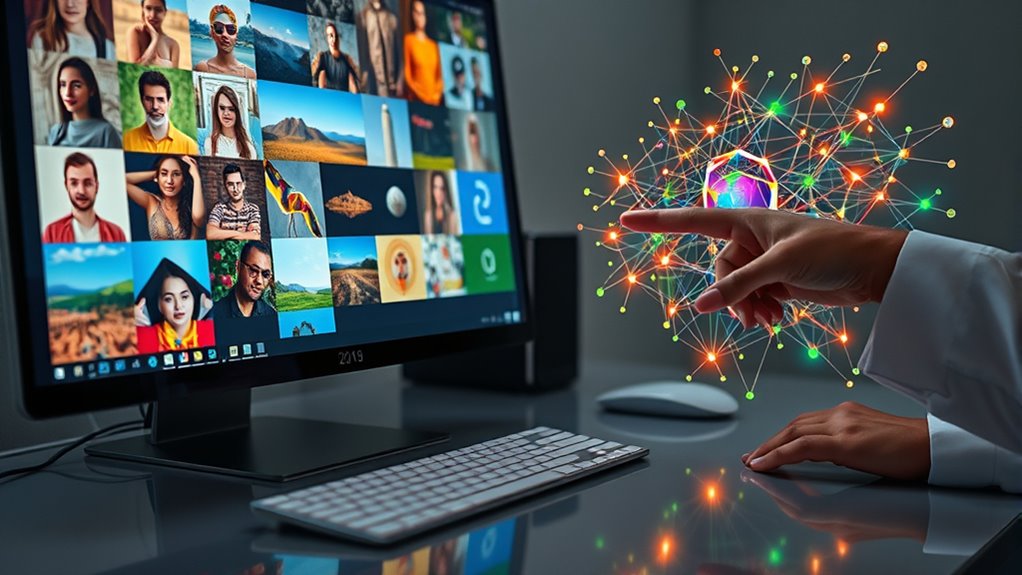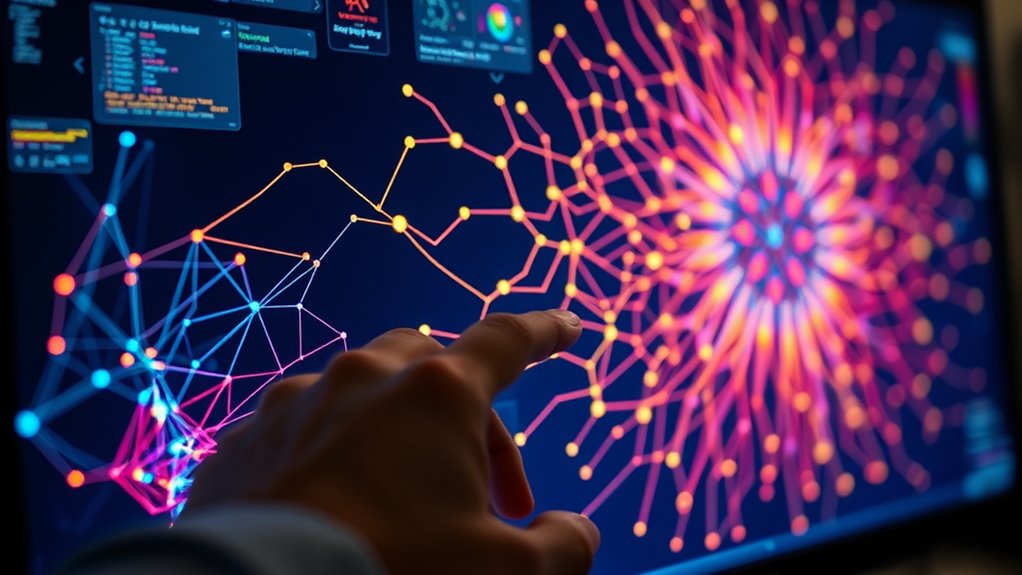AI learns what looks “good” by analyzing images through processes inspired by human perception. It captures visual data, pre-processes it for clarity, and extracts features like shapes and textures. Using advanced models like CNNs and vision transformers, AI identifies patterns and makes judgments similar to how your brain perceives aesthetics. Incorporating neuroscientific insights and attention mechanisms, AI becomes better at understanding scenes and preferences—if you stay tuned, you’ll discover how these techniques shape AI’s sense of beauty.
Key Takeaways
- AI uses feature extraction to identify visual elements that match patterns associated with aesthetic preferences.
- Deep learning models, like CNNs and vision transformers, learn hierarchical and contextual visual features.
- Training on large datasets of images helps AI recognize what humans typically find appealing.
- Neuroscientific insights, such as attention mechanisms, improve AI’s ability to focus on visually salient and attractive regions.
- Incorporating human-like perception models enables AI to better judge and predict what looks “good” to people.

Understanding how AI determines what looks “good” to you involves exploring the complex processes behind visual perception in machines. When you show an image, the AI begins by capturing the visual data through sensors or cameras. The quality of this initial image greatly influences how accurately the AI interprets what it sees. Next, the system pre-processes the image by scaling it, normalizing colors, and reducing noise, ensuring the data is clean and consistent for analysis. These steps are essential for ensuring reliable data input. Once pre-processed, the AI extracts features such as edges, textures, and shapes—these are the building blocks that help it recognize objects and patterns. Think of it as the AI’s way of noticing the important details that define what’s in the picture. Using these features, machine learning algorithms classify and recognize objects, matching them against vast datasets it has been trained on. This training helps the AI understand what looks “good” or typical in each category. Refining the results is the final step. Post-processing may involve tracking objects over time or predicting future states based on visual input. For instance, in a video, the AI can follow a moving object or anticipate where it’ll be next, sharpening its understanding of the scene. Deep learning architectures, especially convolutional neural networks (CNNs), play a *crucial* role. CNNs automatically learn hierarchical features, enabling the AI to identify complex patterns *essential* for tasks like classification and detection. Recurrent neural networks (RNNs) add temporal context when processing sequences of images or video frames. Transfer learning allows AI models pre-trained on large datasets to adapt quickly to new visual tasks, enhancing accuracy and efficiency. Generative adversarial networks (GANs) help generate or improve images, which teaches AI subtle aesthetic qualities. Attention mechanisms further refine this process by letting AI focus on the most important parts of an image, improving its judgment of what looks “good.” Incorporating insights from neuroscientific studies can help AI perception become more aligned with human visual understanding. Training AI with brain-inspired models, like neural activity patterns from the inferior temporal cortex, makes its recognition more robust and aligned with human perception. These models interpret images with greater context sensitivity, helping AI generalize across different or distorted images. This approach highlights the importance of neuroscientific insights. Unlike humans, who use context and prior knowledge to interpret scenes, most AI relies on raw pixel data, limiting its understanding. However, architectures like vision transformers aim to capture broader relationships, making AI’s perception more similar to human visual processing.
Frequently Asked Questions
How Do AI Systems Interpret Subjective Beauty Standards?
AI systems interpret subjective beauty standards by analyzing measurable facial features like symmetry, eye size, and skin quality. They learn from large datasets, often biased toward narrow ideals, and track user interactions like likes and swipes to personalize recommendations. However, these models tend to oversimplify beauty, reducing it to quantifiable traits, which can ignore cultural, emotional, and individual nuances that truly define what you find attractive.
Can AI Adapt to Individual Aesthetic Preferences Over Time?
Absolutely, AI can adapt to your aesthetic preferences over time, like a chameleon changing with its surroundings. By analyzing your feedback and interactions, it refines its understanding, making your experience more personalized. Techniques like reinforcement learning and continuous updates help it stay in tune with your evolving tastes. This ongoing process guarantees AI remains aligned with what you find beautiful, creating a uniquely tailored aesthetic journey just for you.
What Role Does Cultural Bias Play in Ai’s Learning Process?
Cultural bias influences AI’s learning by shaping the data it processes, often reflecting societal stereotypes and norms. When AI trains on biased data, it reinforces stereotypes, marginalizes diverse groups, and perpetuates cultural stereotypes. You might notice AI generating outputs that lack cultural sensitivity or misrepresent certain communities. To improve, developers need to use diverse datasets and incorporate cultural awareness, helping AI better understand and respect different cultural perspectives.
How Transparent Are AI Decisions About What Looks “Good”?
AI decisions about what looks “good” vary in transparency. Sometimes, they reveal their rationale and process, making it easier for you to understand why a certain image, product, or idea is deemed appealing. Other times, the decision remains a black box, showing only the final choice. Your trust depends on how clearly the AI explains its reasoning, especially if it’s tailored to your understanding and needs.
Can Ai’s Aesthetic Judgments Evolve With New Trends?
Imagine a flowing river that reflects changing skies—your AI’s aesthetic judgments can evolve with new trends. It captures shifts by analyzing fresh social media data, predicting emerging styles. But, since it relies on existing patterns, it may lag behind true innovation. While AI adapts over time, your human touch remains crucial for pioneering truly novel aesthetics, ensuring designs stay fresh and aligned with evolving cultural currents.
Conclusion
Understanding how AI learns what looks “good” might seem impersonal or even intimidating, but it’s designed to serve you better. By recognizing the science behind this process, you can trust that AI’s goal is to enhance your experience and help you find what truly appeals to you. Don’t let fear hold you back—embrace these innovations, knowing they’re crafted to make your choices more personalized and enjoyable, just like a trusted friend guiding you along the way.











